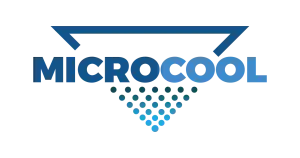Mike Lemche, President of MicroCool, writes in Process Cooling magazine about the ability of evaporative fog to increase the cooling power of condenser coil cooling systems. This is especially relevant for aging equipment, high output systems like data centers, continuous use systems like cold stores.
Spring is a great time for businesses and those in facilities management to look at options for improving the output or extending the life of older systems. Talk to one of our team of experts at MicroCool using experience we’ve gained through over 35 years serving the HVAC industry using our state-of-the-art superior engineered products and design.
Adding reverse osmosis and microfine nozzle technology has positioned evaporative fogging as a reborn technology that can extend the life of air-cooled equipment.
Evaporative Fog Saves Aging Refrigeration Equipment
One of the biggest challenges to engineers and maintenance staff is how to deal with the reduced performance of aging equipment, particularly air-cooled refrigeration and air-conditioning units. With average temperatures increasing, it has become an even larger problem, and restrictive budgets on capital spending further complicate the issue.
Fortunately, an old technology has come to the rescue of such equipment. In previous years, simple water sprinklers were employed to reduce condenser coil surface temperatures, and some water mist systems also were used. However, coil contamination by calcium and magnesium carbonate often drastically reduced thermal transmission, so the concept was abandoned — until recently. Using reverse osmosis water as well as modern fogging nozzle technology that can create extremely fast evaporating particles, evaporative fogging is increasing daily.
Instant Evaporation Drops Temperature: How It Works
Evaporative fogging refers to the pumping of high-pressure (1,000 psi minimum) water forced through a series of tubes and nozzles to create a water mist, or fog. The fog particles are very small — of the order of 10 to 20 microns. Because of their tiny diameter, these particles can evaporate very quickly, resulting in adiabatic cooling of the airstream. Introducing this airstream to an air-cooled condenser can have significantly positive results.
In applications where aging air-cooled condensers and air-conditioning equipment cannot meet the cooling demand, evaporative fogging can provide cooler-than-ambient air to increase performance and enhance cooling. An independent study, commissioned by Southern California Edison, validated the energy usage achieved by evaporative fogging.

Manufacturers data sheets clearly show that air-cooled systems perform better when supplied with cooler air conditions (Table 1). A comparison of performance for a new 100-ton, air-cooled chiller under different ambient conditions shows the inherent decrease in cooling capacity. The system that produces 104.6 tons of cooling at 85°F (29°C) only produces 83.6 tons of cooling at 115°F (46°C).
Furthermore, as the ambient temperature rises, the aging condenser cannot reject as much heat as it once did, making matters even more strained. Reduced cooling causes the compression ratio (head pressure/suction pressure) to increase, resulting in higher saturated liquid temperatures, and system capacity falls dramatically. The system must run longer to achieve the desired cooling and may even shut down under such continued high head pressure.
The introduction of water mist or fog that quickly flash evaporates into the condenser airstream can seriously drop the ambient and thwart, or at least minimize, the decrease in cooling capacity. The end results are capacity retention and energy savings, particularly under peak demand electrical utility billing.
How Much Temperature Reduction Can Be Achieved With Evaporative Fog Cooling?

The question, of course, is how much temperature reduction can be achieved, and under what ambient conditions? Table 2 shows the theoretical temperature reduction in brackets; these values have been quoted for years. Table 2 also shows the practical expectations, which are some 40 percent higher. Experience has shown that there are few perfect days or even days during which we can approximate the theoretical. While they can and do happen, it is not often enough to count on.
Certainly, the areas of highest temperatures can achieve the best ambient reduction, but then, it is exactly these areas that present the biggest problem to aging equipment. These conditions also will demonstrate the highest energy savings.
Algorithms have been developed that use a combination of temperature and humidity to successfully take advantage of the opportune conditions to make aging equipment function at a higher efficiency than would be possible under ambient, and also to demonstrate energy savings through improved cooling capacity.
Typical applications for this technology include:
- Food/warehouse refrigeration systems.
- Air-cooled chillers and condensers.
- Process cooling systems.
- Package HVAC air-cooled systems.
Things to Consider with Evaporative Fogging
Quality Equipment Can Save Energy, Increase Efficiency
Previously, water mist or fog systems generally used low cost equipment — constant-volume triplex-plunger pumps and open-drip-proof (OPD), minimal-efficiency motors — to produce operating pressures of 1,000 to 1,500 psi. No consideration was given to water conditioning or quantity, energy usage or operating times and duration.

Currently, fog systems are much more in tune with technology. While the same 1,000 to 1,500 psi working pressure has been maintained, the systems utilize variable-frequency drives (VFDs) and pressure transducers that chase a fixed setpoint, so energy consumption is at an absolute minimum. A 2 horsepower pump that previously gobbled up 18 amps at full tilt now pulls 3 or 4 amps to simply move the correct amount of water.
Water quality
Likewise, water quality has become a critical factor. In arid regions where mist/fog can potentially be used 10 hours per day, the water must be devoid of mineral salts. To date, reverse osmosis (RO) appears to be the best solution for removing salts and potentially harmful precipitates that can coat coils and rob them of good thermal efficiency. Within the last 10 years the cost of RO membranes has plummeted, making RO a viable, economical alternative to provide clean water. Water-softening equipment, despite its benefits, can be eliminated because of the addition of even more salts to the water. Typically, some municipalities have banned their use for this reason.

Even more recently, tests undertaken with coil cleaning chemicals that attack the biofilm on aluminum fins are showing tremendous potential when injected into the fog/mist spray. The chemical removes the insulating biofilm, improving the thermal transmission significantly.
Replacing a 100-ton, air-cooled unit is a significant capital expenditure and can include some serious downtime. An evaporative system can be used to bring a similar unit back to specification and provide energy savings payback in five years or less, depending on local energy costs.
Case Study: Natural Gas Pipeline | Cooling Data Centers | Photos
Need More Info About Fog Systems For Condenser Coils & A/C Pre-cooling?
phone. 1-800-322-4364 or 1-760-322-1111 | email. fog at microcool.com
Article Originally Published by Process Cooling. Original article available here.
Lemche, Mike. “Evaporative Fog Saves Aging Refrigeration Equipment.” Process Cooling, BNP Media. February 24, 2014. Web.






